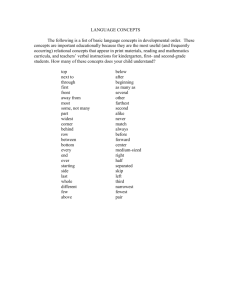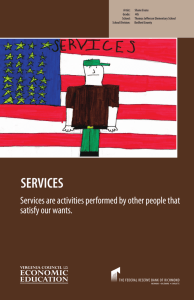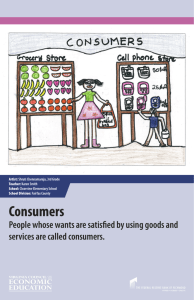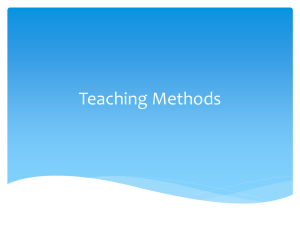COMPETITIVE GRANT APPLICATION Application Due:
advertisement
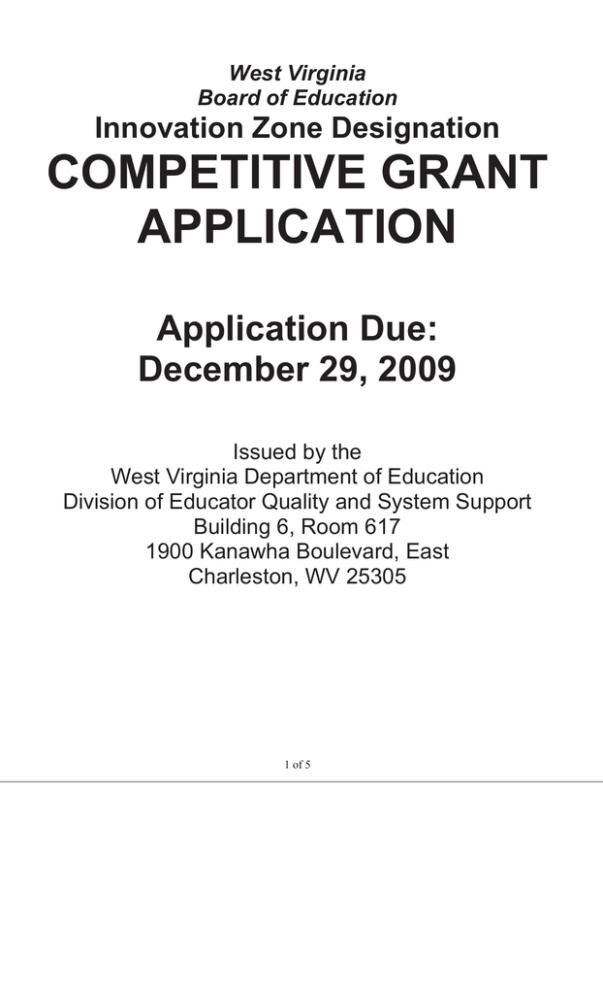
West Virginia Board of Education Innovation Zone Designation COMPETITIVE GRANT APPLICATION Application Due: December 29, 2009 Issued by the West Virginia Department of Education Division of Educator Quality and System Support Building 6, Room 617 1900 Kanawha Boulevard, East Charleston, WV 25305 1 of 5 A. Cover Page B. Information of Applicant: Entity Applying for Innovation Zone Designation __________ A school __________ One or more schools acting as a consortia __________ A group of schools seeking designation across the same subdivision or department of the schools ____√_____ A school seeking designation of a subdivision or department __________ A higher education institution Name of Entity Applying: Shepherdstown Elementary School County: Jefferson Superintendent: Susan K. Wall Number of Professional Personnel: 24 Number of Service Personnel: 11 C. Narratives for the Innovation Zone Application: • Project Design: Shepherdstown Elementary School requests that its Second Grade be designated as an Innovation Zone so that we may design and implement a yearlong sequence of instruction offering our students a fully-integrated, standards-based curriculum that correlates with the Content Standards and Objectives in Reading and Language Arts, Mathematics, Science and Social Studies for West Virginia Schools. This innovative curriculum will be interdisciplinary and will incorporate the four principal academic content areas into a single coherent whole that may be divided into broad bands of understanding and academic accomplishment through problem-based thematic units. It will be highly differentiated to support the needs of all learners while ensuring the highest possible levels of achievement in a challenging, resultsfocused learning environment. Its primary emphasis will be the development of 21st Century learners who solve real-world problems and communicate their thinking effectively with others to be prepared for tomorrow’s workplace. While many of our students experience academic progress within the current curricular framework, others appear unable to generalize this success to real-world applications. They experience learning as a fragmented set of subjects rather than a meaningful endeavor that requires them to use a complementary set of skills and habits of mind to accomplish a series of related tasks that meet a purposeful goal. Students must transcend textbook-based learning that does not align with the requirements of 21st Century careers and acquire instead the skills and knowledge that ensure successful, remunerative employment and genuine lifelong learning to adapt to an ever-changing interconnected world. We begin by focusing on the development of a fully-integrated curriculum for Second Grade given its being the gateway year when students transition from the primary grades’ focus on basic skills acquisition to the content-based learning of the intermediate elementary grades. Second Grade teachers often neglect the required content areas of Science and Social Studies in favor of Reading and Language Arts and Mathematics. Meaningfully integrating all four content areas into a single sequence of learning is an ambitious but genuinely worthwhile goal as it will give teachers the means to teach the entire curriculum; to do so will require considerable reflection and planning to identify the best methods and resources that build both 2 of 5 knowledge and skills in a consistent, developmentally appropriate fashion. Many synergies and efficiencies will be created as Science will no longer be divorced from Mathematics while Reading and Language Arts instruction may benefit from understandings in the spheres of Social Studies and Science such as multiculturalism and environmental awareness. A further example of such synthesis might be students developing storytelling and expository writing skills in Mathematics while considering a socially-relevant historical problem. By thoughtfully designing and then implementing a yearlong sequence of instruction in a fullyintegrated curriculum, such seamless learning will become commonplace rather than an occasional occurrence. Few teachers have the time or professional development required to design such an overarching, comprehensive curriculum in advance although they would likely implement one were it available. Our second-grade students will consistently benefit from well-planned units that relate well to one another and contribute to a “big picture” view of their world. This integrated, project-based approach to learning is often used by many of the nation’s best private schools to train tomorrow’s leaders; students in West Virginia’s public schools deserve the same opportunity for leadership. The exact design of the fully-integrated curriculum for Second Grade would be developed during Phase 2 of the proposed project. A highly-qualified curriculum specialist would be given time and resources to analyze and then integrate the Content Standards and Objectives in the four content areas for Second Grade based on a thorough review of best practices and knowledge and experiences garnered by curriculum and instruction experts in our state and elsewhere. For example, the fully-integrated curriculum would likely reflect key understandings brought about by the Teacher Leadership Institute’s Project Based Learning and the Science with Inquiry Modules and Problem-based Learning Experiences (SIMPLE) programs as well as other initiatives supported by the West Virginia Department of Education’s Office of Instruction. The integrated curriculum would provide both a scope and sequence for learning as well as offer detailed instructional plans that include specific resources, whether texts or materials, to optimize students’ opportunities for meaningful, hands-on learning throughout the year. It will likely be necessary for the curriculum specialist to acquire sufficient resources prior to implementation to maximize instructional time and focus. Initially, upon implementation, three second-grade teachers (Ivy Avery, Lee Ebersole, and Liza Jonczak) would facilitate instruction for some 75 second-grade students at Shepherdstown Elementary School using the fully-integrated curriculum designed during Phase 2 of the proposed Innovation Zone Project. All our second-grade students would participate in the project and therefore experience learning through the integrated curriculum rather than the separated content areas as would students in other grades at our school. Their daily routines would be altered to reflect this significant change. In the beginning, they might be perceived as a “school within a school” at Shepherdstown Elementary as the entire school community would be aware of Second Grade having adopted an alternative, innovative approach to learning. A likely goal in subsequent project years would be to design and implement fully-integrated curricula in other grades at Shepherdstown Elementary possibly starting with either First or Third Grade. In the near term, however, no other faculty or service personnel would be directly affected by the Innovation Zone project’s design as it is essential that the fully integrated curriculum be designed to meet all performance requirements of the state-mandated curricula for the four content areas; thus, our second-grade students would be well prepared to learn in subsequent grades that use traditional approaches to instruction. Another possible outcome of the project would be the use by other second-grade classrooms in Jefferson and other West Virginia counties of the integrated curriculum developed during the planning phase, especially as it is refined through lessons learned during implementation and then serves as a model for 21st Century learning. 3 of 5 • Research Base: In his article, “Toward a Connected Core Curriculum,” in the current issue of Educational Horizons, William Wraga presents three rationales for an interdisciplinary, connected core curriculum as an alternative to the disconnected, subject-centered curriculum: 1. “… attention to the connections between and among students’ experiences in the curriculum, both vertically and horizontally, should ensure that all experiences are complementary; they will thus foster the cumulative impact of all learning experiences; 2. … the reality that experience is integrated; the school should enable students to understand the complex interrelatedness of experience; 3. … social problems and issues transcend disciplinary boundaries and that a major purpose of public schooling is preparing enlightened citizens who can make intelligent decisions about public problems; the curriculum, then, must provide opportunities for students to integrate and apply subject knowledge so they can understand and confront complex social problems (Wraga, Educational Horizons, v87, p88-96, Win 2009).” Wraga concludes that such a connected, fully-integrated approach to curriculum would be highly beneficial to students as they “... might better learn subject matter, find their academic experiences more meaningful and useful ….” Other researchers have investigated the potential benefits of curriculum integration organized around real-life problems and issues significant to students: • In the June 2000 ERIC Digest, “Integrative Curriculum in a Standards-Based World,” Gordon Vars and James Beane described how schools can benefit from student-centered integrative curriculum while also developing core competencies. They concluded that “Almost without exception, students in any type of interdisciplinary or integrative curriculum do as well as, and often better than, students in a conventional departmentalized program.” • More recently, Mark Girod and Todd Tymann found statistically significant differences in favor of blended curricula in their report, “Comparing the Added Value of Blended Science and Literacy Curricula to Inquiry-Based Science Curricula in Two 2nd-Grade Classrooms” (Girod and Tymann, Journal of Elementary Science Education, v21, n3, p13-32, Sum 2009). • Rebecca Olness suggested how to teach both content and literacy concepts simultaneously in her book, Using Literature to Enhance Content Area Instruction: A Guide for K-5 Teachers, published by the International Reading Association (2007) by providing research-based strategies for developing integrated curricula in Social Studies, Science, Mathematics and the Arts, with extensive children’s literature bibliographies. 4 of 5 • Policies or Code that Prohibit or Constrain the Design: o _____Waiver Requested of County Policy: o _____Waiver Requested of WVBOE Policy or Regulation: o _____Waiver Requested of Statute: o __√__ N/A (No Waiver Requested) • Planning Narrative and Budget Page: The budget requests for the planning phase for the Second Grade Curriculum Integration include funding to employ a consultant specializing in primary curriculum and instruction, funding for the three elementary teachers who will integrate the plan, and funding for supplemental instructional materials. The Curriculum and Instruction specialist will provide the framework for integrating cross-curricular materials within the requirements of the WV Content Standards and Objectives. Through professional experience with integrated curricular materials, the consultant will help shape a curriculum that fosters the development of students who can apply their learning to real-world problems. The three second grade teachers will provide the classroom expertise to map the curriculum onto the school year by assuring that essential learning objectives are synchronized with the prescribed curricular goals for the second grade year. The teaching staff will develop the assessment systems that measure student progress maintaining consistency with the WV CSOs. The consultant will recommend replacement and supplemental educational materials that are cross-curricular in nature. Use of materials that embrace a diversity of subject matters will reduce the redundancy of materials used in teaching isolated subjects. This proposal is for a total of $25,000 for planning for the second grade curricular integration innovation. The professional curriculum specialist will receive $7500. for up to 50 hours of curriculum development valued at $100. per hour and $2500. for travel and expenses to meet with the second grade team. Each of the three team members will be paid $2500. to cover an estimated 100 hours of time and $500 to cover travel and expenses to meet with the consultant. The funds will cover expenses related to meeting with the team, integrating the curriculum design, developing assessments and developing transitional strategies at the grade level and with the preceding and succeeding grades. The grant requests $10,000 to purchase supplemental cross-curricular materials identified by the curriculum specialist as appropriate for this teaching model. Curriculum Specialist 3 Professional educators Curriculum Development (50 hrs. @ $100. per) $5000. Travel and expenses $2500. Curriculum Integration (100 hrs. @ $20. per) $6000. Travel and expenses $1500. Curriculum materials for three classrooms $10,000. Total $25,000. 5 of 5
